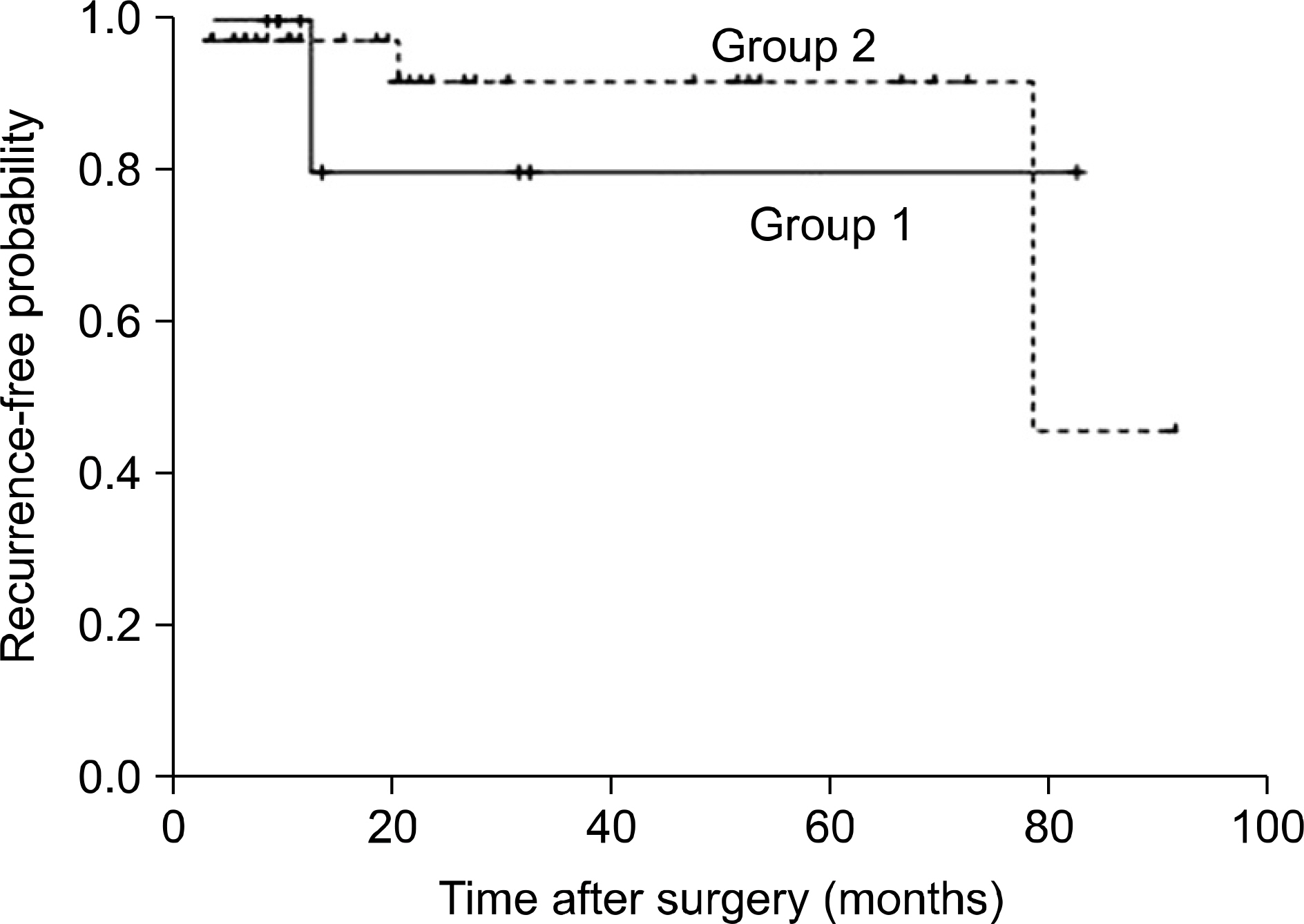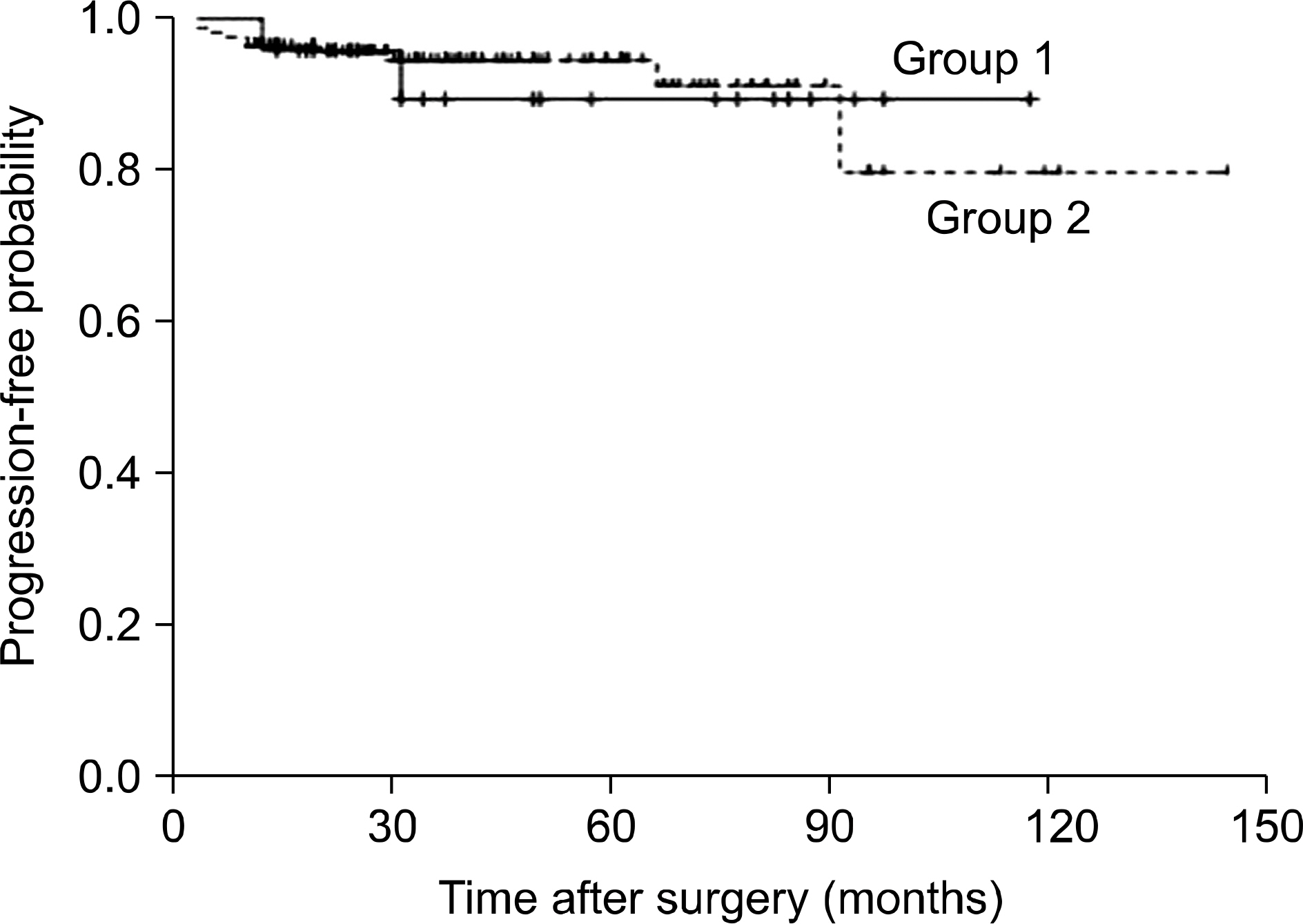Korean J Urol.
2009 Jun;50(6):534-539. 10.4111/kju.2009.50.6.534.
Effects of Simultaneous Transurethral Resection of Non-Muscle-Invasive Bladder Cancer and Benign Prostatic Hyperplasia
- Affiliations
-
- 1Department of Urology, Ajou University School of Medicine, Suwon, Korea. sejoong@ajou.ac.kr
- KMID: 1989783
- DOI: http://doi.org/10.4111/kju.2009.50.6.534
Abstract
-
PURPOSE: To evaluate the effects of simultaneous transurethral resection of bladder tumor (TURB) and transurethral resection of prostate (TURP) in patients with non-muscle-invasive bladder cancer and benign prostatic hyperplasia (BPH).
MATERIALS AND METHODS
From March 1995 to February 2007, TURB was performed for transitional cell carcinoma (TCC) of the bladder in 395 men by a single surgeon. Among these patients, 24 patients underwent TURB and TURP simultaneously for BPH as well as non-muscle-invasive TCC without bladder neck or prostatic urethral invasion and were followed up for at least 12 months (group 1). For purposes of comparison, the data from 165 men who underwent TURB alone for non-muscle-invasive TCC of the bladder (group 2) were also reviewed.
RESULTS
There were no significant differences in the clinicopathological variables of bladder cancer between the 2 groups. The 60-month overall recurrence-free, recurrence-free at bladder neck or prostatic urethra, and progression-free probability were 68.4%, 80.0%, and 89.4% in group 1 and 72.5%, 91.9%, and 94.5% in group 2, respectively. Kaplan-Meier curves showed that there were no significant differences in the overall recurrence-free rate (p=0.688), recurrence-free rate at bladder neck or prostatic urethra (p=0.867), or progression-free rate (p=0.885) between the 2 groups. Among the clinicopathological variables, no predictor of recurrence was identified in group 1.
CONCLUSIONS
Simultaneous TURP during TURB does not increase the recurrence or progression rates of bladder cancer. TURP can be safely performed during TURB in patients with non-muscle-invasive bladder cancer and BPH.
Keyword
MeSH Terms
Figure
Reference
-
1.Parekh DJ., Bochner BH., Dalbagni G. Superficial and muscle-invasive bladder cancer: principles of management for outcomes assessments. J Clin Oncol. 2006. 24:5519–27.
Article2.Park JW., Park CH., Kim CI. Superficial bladder carcinoma treated with Bacillus Calmette-Guerin: minimum 5-year follow up results. Korean J Urol. 2003. 44:573–8.3.Jung S., Jung SI., Chung JI. Bacillus Calmette-Guerin intravesical therapy in superficial bladder cancer: the early experience of comparison of 6 week course and modified 6+3 maintenance therapy. Korean J Urol. 2008. 49:703–8.
Article4.Lee SC. Intravesical therapy for superficial bladder cancer: advances and future. Korean J Urol. 2000. 41:467–79.5.Soloway MS., Masters S. Urothelial susceptibility to tumor cell implantation: influence of cauterization. Cancer. 1980. 46:1158–63.
Article6.Pode D., Alon Y., Horowitz AT., Vlodavsky I., Biran S. The mechanism of human bladder tumor implantation in an in vitro model. J Urol. 1986. 136:482–6.
Article7.Weldon TE., Soloway MS. Susceptibility of urothelium to neoplastic cellular implantation. Urology. 1975. 5:824–7.
Article8.Kiefer JH. Bladder tumor recurrence in the urethra: a warning. J Urol. 1953. 69:652–6.
Article9.Hinman F Jr. Recurrence of bladder tumors by surgical implantation. J Urol. 1956. 75:695–6.
Article10.Ugurlu O., Gonulalan U., Adsan O., Kosan M., Oztekin V., Cetinkaya M. Effects of simultaneous transurethral resection of prostate and solitary bladder tumors smaller than 3 cm on oncologic results. Urology. 2007. 70:55–9.
Article11.Tsivian A., Shtricker A., Sidi AA. Simultaneous transurethral resection of bladder tumor and benign prostatic hyperplasia: hazardous or a safe timesaver? J Urol. 2003. 170:2241–3.
Article12.Kouriefs C., Loizides S., Mufti G. Simultaneous transurethral resection of bladder tumour and prostate: is it safe? Urol Int. 2008. 81:125–8.
Article13.Greene LF., Yalowitz PA. The advisability of concomitant transurethral excision of vesical neoplasm and prostatic hyperplasia. J Urol. 1972. 107:445–7.
Article14.Laor E., Grabstald H., Whitmore WF. The influence of simultaneous resection of bladder tumors and prostate on the occurrence of prostatic urethral tumors. J Urol. 1981. 126:171–2.
Article15.Vicente J., Chéchile G., Pons R., Méndez G. Tumor recurrence in prostatic urethra following simultaneous resection of bladder tumor and prostate. Eur Urol. 1988. 15:40–2.16.Karaguzhin SG., Merinov DS., Martov AG. One-stage transurethral resection of the urinary bladder and the prostate in patients with superficial cancer of the urinary bladder combined with benign prostatic hyperplasia. Urologiia. 2005. 5:17–21.17.Ham WS., Kim WT., Jeon HJ., Lee DH., Choi YD. The significance of simultaneous transurethral resection of bladder tumor and the prostate in patient who have superficial bladder cancer with bladder outlet obstruction. Korean J Urol. 2008. 49:791–6.
Article18.Oosterlinck W., Lobel B., Jakse G., Malmström PU., Stöckle M., Sternberg C. European Association of Urology (EAU) Working Group on Oncological Urology. Guidelines on bladder cancer. Eur Urol. 2002. 41:105–12.
Article19.American Joint Committee on Cancer. AJCC cancer staging manual. 5th ed.Philadelphia: Lippincott-Raven;1997. 241-3.20.Epstein JI., Amin MB., Reuter VR., Mostofi FK. The World Health Organization/International Society of Urological Pathology consensus classification of urothelial (transitional cell) neoplasms of the urinary bladder. Bladder Consensus Conference Committee. Am J Surg Pathol. 1998. 22:1435–48.21.El-Abbady AA., Shoukry MS., Hanno AG., Younis LK., Abdel-Rahman M. Repeated transurethral resection of recurrent superficial bladder tumors-does it affect the spread and stage of the tumor? Scand J Urol Nephrol. 2002. 36:60–4.22.Mydlo JH., Weinstein R., Shah S., Solliday M., Macchia RJ. Long-term consequences from bladder perforation and/or violation in the presence of transitional cell carcinoma: results of a small series and a review of the literature. J Urol. 1999. 161:1128–32.
Article23.Page BH., Levison VB., Curwen MP. The site of recurrence of non-infiltrating bladder tumours. Br J Urol. 1978. 50:237–42.
Article24.Boreham P. The surgical spread of cancer in urology. Br J Urol. 1956. 28:163–75.25.Golomb J., Gorelik U., Keler T., Lindner A. Incidence and pattern of bladder tumor recurrence following combined suprapubic prostatectomy and excision of a bladder tumor. Eur Urol. 1989. 16:86–8.26.Lepor H. Pathophysiology, epidemiology, and natural history of benign prostatic hyperplasia. Rev Urol. 2004. 6(Suppl 9):S3–10.27.Bischoff CJ., Clark PE. Bladder cancer. Curr Opin Oncol. 2009. 21:272–7.
Article
- Full Text Links
- Actions
-
Cited
- CITED
-
- Close
- Share
- Similar articles
-
- Intraoperative ventilation and hemodynamic change due to bladder perforation during transurethral resection of a bladder tumor: A case report
- Fluid extravasation caused by bladder perforation during bipolar transurethral resection using saline solution: a case report
- Clinical Results of Transurethral Resection for the Benign Prostatic Hypertrophy -Significance of Suprapubic Cystostomy before Transurethral Resection-
- Comparison of the Finding of Transrectal Ultrasonography and the Result of Transurethral Resection of Prostate according to the Histologic Types in Benign Prostatic Hyperplasia
- The Effects of Concomitant Prostatic Calculi to the Therapeutic Results in Patients with Chronic Bacterial Prostatitis




